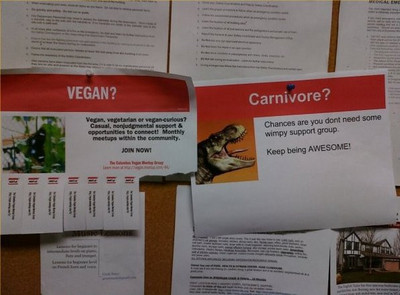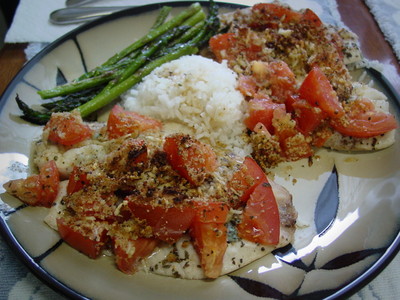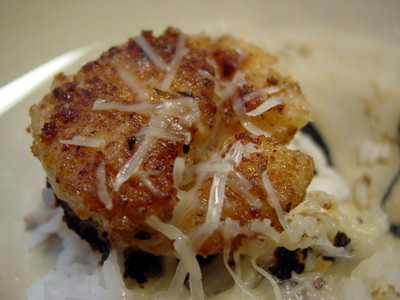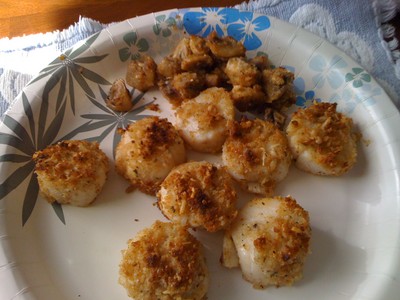Salmon and Yammon
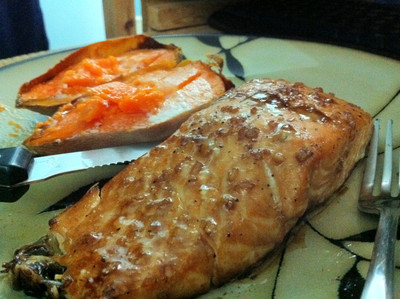
It’s not every day that you discover a new favorite meal, let alone one that’s easy to make. But this meal here, just some salmon and a yam, is definitely one of my new favorites, and it could hardly be any easier to make. Kim found the maple salmon recipe; for the yam, you just bake it at 350F for an hour, then add butter.
I generally love seafood, but have stayed away from salmon because the first and only time I ever tried it, a few years ago, it was really fishy-tasting and gross. But since I’ve been learning about how screwed up our omega-6 to omega-3 fatty acid balance is -- it should be close to a 1:1 ratio but in the typical American it’s more like 10:1 or 20:1 -- I’ve really wanted to get more omega-3 in my diet. And oily fish like salmon are pretty much the only significant dietary source of omega-3.
So I mentioned to Kim that I wanted to try salmon again, and she found that recipe and cooked it up for me. It was amazing, and I’ve been making it about twice a week now. And this is just farm-raised Atlantic salmon (from Wegmans); I can’t imagine how good the wild-caught Coho and King salmon that Rolly’s been telling me about might be.
Super-Easy (But Still Awesome) Low-Carb Meals
A couple of months ago I decided to stop overdosing on carbohydrates. I’m not really on a low-carb diet per se, but I did cut my daily carb intake to around 90 grams. Low-carb diets start around 20 grams and work their way up a bit from there over time, and I don’t think 90 grams would be considered particularly low by true low-carbers -- but it’s far lower than the 300+ grams consumed by people on the SAD diet (Standard American Diet), which heretofore included me.
About half of my carb drop came from giving up sweetened iced tea, of which I used to drink about 60 fl oz each day (I now drink water instead). The other half came from switching my meals from primarily Stouffer’s frozen dinners (which are delicious and there are tons of varieties of them, but they’re mostly pasta-based) to primarily real whole food that I cook myself. But cooking meals and doing dishes is a pain in the butt, which now consumes a couple hours out of each day for me.
Recently I hit upon a good solution: Bertolli Frozen Meals. There are over a dozen varieties including beef, chicken, shrimp, and pork, with various vegetables, and you just dump the bag into a skillet and cook for 12 minutes or so. Most of them do contain pasta, but here’s the thing: the way they’re packaged, each ingredient is separately pre-cooked before being frozen and then put into the bag, including little blocks of frozen sauce. So since the sauce isn’t all over everything, it’s super easy to just pick out the pasta and chuck it before cooking, thereby removing 95% of the carbs. What’s left is a nice and healthy meal of meat, fat, and vegetables.
Of course I won’t be replacing all my meals with these, but they do provide a nice way to have a good meal without all the hassle of preparing something from scratch.
Everything You Know About Health Is Wrong
Part 1: Fat
How many scientific studies do you think there are which show that saturated fat causes heart disease? A couple of months ago, I would have guessed "several", if not "lots", or at the very least, "one." As it turns out, the answer is zero, and this is despite the government having spent decades and hundreds of millions of dollars trying to find just such a causal relationship between evil dietary fat and heart disease.
The truth is that eating fat is not only not bad for you, it also does not make you fat. The body does not simply store the fat we eat; rather, it stores fat in response to elevated insulin levels -- and it is dietary carbohydrates that cause elevated insulin levels. The body also converts excess carbs into fat and then stores it, so a "low-fat", high-carb diet -- the kind that the government has been recommending for decades -- actually results in increased fat storage. So we’ve got a nation of obese diabetics who are hysterically anti-fat and are stuffing themselves -- killing themselves -- with grains.
I first started learning about this stuff a couple of months ago via Tom Naughton’s excellent videos Fat Head and Big Fat Fiasco. (Update: and Fat Head is now available for free instant streaming on Hulu, and free-for-members instant streaming on Netflix.) But none of this is actually news; the proof for it is all over the scientific literature and all over the web. For example, the following two long and detailed articles (both definitely worth your time to read in full) are several years old by now:
Quoting Men’s Health:
What if "bad" fat is actually good for you? For decades, Americans have been told that saturated fat clogs arteries and causes heart disease. But there’s just one problem: No one’s ever proved it.
And:
Quoting New York Times:
These researchers point out that there are plenty of reasons to suggest that the low-fat-is-good-health hypothesis has now effectively failed the test of time. In particular, that we are in the midst of an obesity epidemic that started around the early 1980’s, and that this was coincident with the rise of the low-fat dogma. (Type 2 diabetes, the most common form of the disease, also rose significantly through this period.) They say that low-fat weight-loss diets have proved in clinical trials and real life to be dismal failures, and that on top of it all, the percentage of fat in the American diet has been decreasing for two decades. Our cholesterol levels have been declining, and we have been smoking less, and yet the incidence of heart disease has not declined as would be expected. "That is very disconcerting," Willett says. "It suggests that something else bad is happening." [...]
Rather it occurred...because the public health authorities told us unwittingly, but with the best of intentions, to eat precisely those foods that would make us fat, and we did. We ate more fat-free carbohydrates, which, in turn, made us hungrier and then heavier.
If you want to go deeper into the details, from article-level to book-level, Gary Taubes’ Why We Get Fat and Robb Wolf’s The Paleo Solution are both highly recommended. I have a stack of about half a dozen books that I want to read (mostly not health-related), and I normally don’t skip ahead, but I made exceptions for both of these.
The work of Dr. Cordain and the Drs. Eades are also great sources of information on diet.
Part 2: Disease
Unfortunately, being fat is just one of the consequences of a high-carb diet; the other consequences of this "healthy" way of eating include diseases like diabetes, heart disease, and Alzheimer’s. It’s not fat that causes these diseases, but rather a combination of inflammation and autoimmune disorder. Grains like wheat are the biggest instigator of the gut irritation that leads to these disorders -- though legumes and dairy are also problematic for many people -- and the irritation is often at a low enough level that there are few if any symptoms, despite the damage that’s being done. That damage leads to what’s known as leaky gut:
Disease occurs when the tight junctions become "leaky" allowing pathogens to enter by the paracellular pathway. When this occurs, the GALT immune system will become activated. However, during this stimulation, the GALT system may produce antibodies which cross react with native proteins. Thus, autoimmune diseases may occur like Type I Diabetes Mellitus which is an autoimmune disease against the beta cells of the pancreas. This leads to decreased insulin production by the pancreas.
In other words, foods that irritate the gut put it in a weakened state, and in this state, the gut allows not just nutrients to enter our bodies, but also pathogens. The immune system mounts attacks against these pathogens, but some of what leaks through are things like undigested proteins, which can be similar to our own proteins, resulting in our own proteins being targetted by our immune system’s response -- hence, autoimmune disease.
Then of course there’s type II diabetes, which is actually caused by a high-carb diet directly. When you overload your system with sugar (i.e. carbohydrate, whether from grains or refined sugars) for long enough, your tissues become insulin resistant, because your pancreas is constantly pumping out massive amounts of it in order to bring down your blood glucose levels. Your cells no longer respond properly to insulin: they don’t pull much glucose out of the bloodstream, which results in a chronically high blood sugar level, and also results in you feeling chronically hungry, because your cells (in your muscles, etc) are not getting the energy (glucose) that they need. As an added bonus, your liver steps up and converts the excess blood glucose to fat which gets stored in your fat cells.
Part 3: The Cure
The cure for all of this is simple: eat the foods that your body was designed to consume: meats, vegetables, fruits, nuts, and seeds, with emphasis on meats and vegetables. This kind of diet is known as the Paleo diet, since it’s what humans ate before the dawn of agriculture; it’s what everyone ate for most of human history. This way of eating is automatically low-carb, unless you load up on super-starchy "vegetables" like potatoes and corn, which is not advisable.
Or to view it from the foods-to-avoid perspective: simply avoid grains, legumes, and dairy.
Part 4: The Podcast
If you want a huge source of invaluable information on health and nutrition that’s also entertaining and totally free, listen to Robb Wolf’s Paleo Solution podcast. Robb is a fitness trainer and an expert in nutrition and physiology, and his depth of knowledge is astounding. For an hour each week he answers reader/listener questions, and it’s one of the most fascinating and informative shows I’ve ever heard. Parts of it are pretty heavily focused on strength training, which I’m not hugely interested in, but it all generally comes back to the same principles regarding how to fuel your body for optimum health.
One of my favorite things about the podcast is the stories of all the clients Robb has helped, in many cases curing people of diseases (not to mention fixing tons of smaller problems like IBS, acne, etc), just by correcting their diets. People are often reluctant to give up bread, pasta, etc, but they get over that after taking the 30 day challenge, which is simply to cut out grains, legumes, and dairy from your diet for 30 days, and see if you don’t look, feel, and perform better. It doesn’t cost you anything to try, the potential upside is huge, and the only downside is missing out on some foods that you like for a few weeks.
Part 5: Testimonials
There are quite a few testimonials on Robb Wolf’s website, along with a whole category for them on his blog. Here is one from a recent podcast (episode 65, about 30 minutes in):
Quoting Robb Wolf:
Interesting back-story: the whole reason that Paleo Brands exists is that John Welbourn’s neighbor Joe, he went with John to a Paleo talk that John did. I was supposed to do one down at CrossFit LA for Andy Petranek, and due to some scheduling stuff I couldn’t show up, so John gave the talk for me, and he took Joe with him.
Joe is Italian, and his mom’s really Italian, like from-Italy Italian, but after Joe heard about all this stuff, he told his mom, hey mom, I want you to not eat pasta and bread, and I want you to eat meat, and fruit, and vegetables, and all this stuff. And Joe’s mother is in her 60s; she had had alopecia since she was in her early 40s, and her hair had just fallen out -- she had to wear a wig.
And then Joe didn’t see his mom for about two months, and then the next time he saw her, her hair was growing all back in, and the guy like collapsed on the ground crying when he saw his mom. And then he was like, we’ve gotta get this [Paleo diet] idea out to everybody.
So it’s really remarkable how beneficial that autoimmune intervention is, the Paleo flavor of autoimmune intervention, for things like alopecia, vitiligo, and a number of skin and hair-related issues, psoriasis, eczema, and on and on and on. It’s definitely worth a shot.
Eating Fat Is Not Bad For You
This is one of those things that’s seemed vaguely obvious to me for a long time. It never made any sense when so-called experts -- who generally turn out to be government stooges -- released grand statements claiming that natural foods like meat, eggs, milk, and butter were unhealthy. The other day I came across a video that kind of pulled it all together.
The video is called Big Fat Fiasco (that link goes to part 1; you’ll see links to the subsequent parts after it’s over) and it was very interesting and informative. The video’s creator, Tom Naughton, explains how the whole eating-fat-is-bad-for-you concept was created largely by a single scientist named Ancel Keys. Keys had to throw out most of his data in order to reach the conclusion that he had previously decided was correct -- that eating fat is bad and causes heart disease. But then, study after study failed to substantiate his theory, so naturally it was discarded the government got involved.
Quoting Big Fat Fiasco:
This [low-fat] diet, this [lipid] hypothesis, was failing over and over in clinical research ... What could have possibly kept such an unscientific, discredited, and possibly even harmful idea alive? ... A government committee.
Dr. Robert Olson: "I have pleaded in my report, and will plead again orally here, for more research on the problem before we make announcements to the American public."
Senator George McGovern: "I would only argue that senators don’t have the luxury that a research scientist has, of waiting until every last shred of evidence is in."
So the "heart-healthy benefits" of a low-fat diet became national policy because senators don’t have time to wait for all the evidence to come in.
The McGovern Committee’s report -- written by a vegetarian, of course -- recommended that Americans eat less fat, and started the government’s decades-long propaganda blitz telling us we should avoid fat and eat lots of carbohydrates, leading to the obesity epidemic that we’re in today.
Naughton goes on to point out the "French Paradox," which is that they eat twice as much saturated fat, four times as much butter, three times as much pork, and 60% more cheese than Americans, yet have only one-third as much heart disease. There is also the "Swiss Paradox:" they have the second-highest intake of saturated fat, yet the second-lowest rate of heart disease.
You should check out these short videos on Naughton’s site; they’re pretty funny and they shoot down some of the anti-fat hysteria that the government has been pushing for decades. They also point out how the "Super Size Me" video -- I can’t bring myself to call it a documentary -- was essentially BS, and the creator, Morgan Spurlock, appears to have lied about his caloric intake during the time, and has refused all requests to release his food log. I’m no fan of McDonald’s, but nor am I a fan of anti-meat/anti-capitalism propaganda.
Gary Taubes also has a good article and a couple books on the subject, and somewhere on one of these guys’ sites, I read a comment that really made sense to me. It said that eating a low-fat diet actually causes your body to create and store more fat, because your body interprets a lack of dietary fat to mean that it’s in a food-scarce environment, and thus it adjusts your metabolism accordingly, storing more energy in order to survive the period of famine.
Dinner
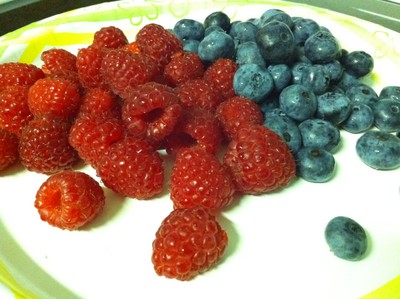
These huge raspberries are delicious, and the blueberries (also very good) provide a nice contrasting flavor.
Being Fat is Bad for Your Brain
Quoting Olivia Judson:
That, at least, is the gloomy conclusion of several recent studies. For example, one long-term study of more than 6,500 people in northern California found that those who were fat around the middle at age 40 were more likely to succumb to dementia in their 70s. A long-term study in Sweden found that, compared to thinner people, those who were overweight in their 40s experienced a more rapid, and more pronounced, decline in brain function over the next several decades.
I’m not sure why this is "gloomy" news, though. It essentially means that you can do something to decrease the odds of getting these horrible late-life mental conditions: keep your body healthy.
Great Tilapia Dish
Weighing the Evidence on Exercise
Quoting Gretchen Reynolds:
The newest science suggests that exercise alone will not make you thin, but it may determine whether you stay thin, if you can achieve that state. [...]
The exercising rats metabolized calories differently. They tended to burn fat immediately after their meals, while the sedentary rats’ bodies preferentially burned carbohydrates and sent the fat off to be stored in fat cells. The running rats’ bodies, meanwhile, also produced signals suggesting that they were satiated and didn’t need more kibble. ... Running had remade the rats’ bodies so that they ate less.
The article has lots of interesting stuff in it from different studies, many involving humans rather than rats. The main idea is that yes, exercise is important for weight control, but not necessarily in the way you’d expect.
Perfect Scallops with Rice and Mushrooms
Kim made this last night. It’s an instant favorite. The scallops were perfect: crispy on one side and soft on the other. The rice by itself was delicious, and even better with the cheese and scallops. It looks like the mushrooms weren’t technically part of the recipe, but every meal could use a side of sautéed mushrooms as far as I’m concerned. This might unseat Carrabba’s Spiedino Di Mare as my favorite scallop dish; they’re not necessarily similar, but both are amazing.
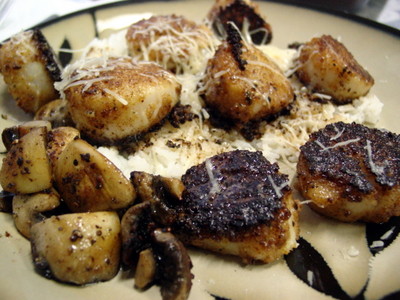
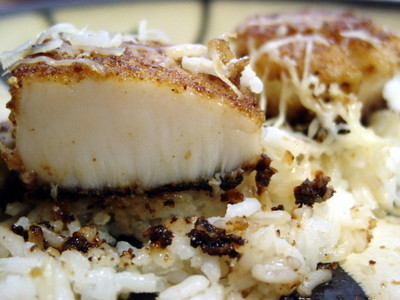
Why Cilantro Tastes Like Soap
Quoting The New York Times:
Flavor chemists have found that cilantro aroma is created by a half-dozen or so substances, and most of these are modified fragments of fat molecules called aldehydes. The same or similar aldehydes are also found in soaps and lotions and the bug family of insects.
In other words: BECAUSE IT IS SOAP. Green, evil soap.
Chicken Bouillon Cube Ingredients
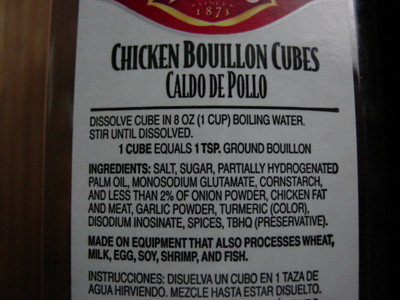
I guess it could be worse; MSG could be the first ingredient. Still, it’d be nice if something chicken-related appeared above the 2% mark. But what’s really outrageous is that there’s no bouillon in it at all!
Gore Mountain Ski Trip
A few weeks ago, Kim and I took a little ski trip to Gore Mountain, New York. We’d never been there before, and this was only my third time skiing, so it was a new and exciting adventure.
We set out on a Tuesday around 1 PM, and arrived around 9 PM. The trip is nominally 6.5 hours, but we had a couple of detours for wild goose chases looking for restaurants that were listed on the iPhone maps app, but turned out to not exist (note: don’t trust any "sponsored links" in there, and always check the satellite view to make sure the "restaurant" isn’t on a back road in the middle of nowhere).
We also hit some pretty serious snow during the last hour or so of the drive, which slowed us down quite a bit. But our timing couldn’t have been better, because overnight the Gore Mountain area got about 18 inches of snow. In fact, it snowed the entire time we were there, including another ~10 inches the second night/day, which made the whole trip extra awesome. Here’s the view from our room’s deck on the first night:

Welcome to North Creek
The little town of North Creek NY is a charming and sleepy place. It’s a nice 20-minute drive from the highway, and when you get there, you wouldn’t necessarily know that you’re right next to a big popular ski mountain. We’ve resolved to take ski trips during the week to avoid the crowds and long lines, which makes the skiing much better, but we discovered that North Creek is kind of a ghost town during the week -- which is just fine, as far as we’re concerned.
The whole town is basically one short main street with 10 or so local restaurants mixed amongst houses and small hotels. When we arrived around 9 PM, all but one of the restaurants was closed, and that one -- barVino -- looked nice but was more of a wine bar than a proper restaurant, and since it was empty and closing soon, we ended up just snacking in our room.
I don’t think there is a single 24-hour establishment in North Creek, which is kind of strange when you’re used to there being several 24-hour grocery stores and convenience stores within a 5-10 minute drive at all times. On the one hand it’s nice, but around 9 PM on the second night, I developed a runny nose that just wouldn’t stop, which made it very difficult to sleep; I would have paid a lot of money for some Nyquil. There’s also no cell phone signal in the town, but fortunately there was free wifi at our hotel. The ski area was a few miles away and it did have cell coverage.
The Adirondack Alpine Lodge
We stayed at The Alpine Lodge, and I was extremely impressed with it. It seems brand new and was very clean and nice. The small hotel is well-designed, with large overhangs that keep the walkways -- and each room’s private deck -- free of snow. The decor is very rustic, and all the furniture is beautiful and hand-made from mostly raw wood (i.e. tree branches). The shower, though a little small, had great pressure, and the tile floor in the bathroom seemed to be heated. The room had a flat-screen TV with built-in DVD player, which as Netflix lovers we really appreciated; it seems that hardly any hotels have DVD players so we were pleasantly surprised. The private deck was quite nice and since it was covered, it was really convenient for us to just leave our cooler outside; we didn’t have to refill the ice at all.
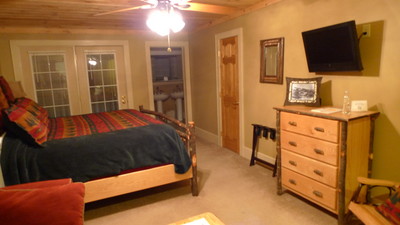
The lodge also has a neat policy for check-in and check-out: the doors have keypads instead of keys or cards, so they give you a code when you make your reservation, which means you can just show up and go right into your room without really checking in at all. In fact there is no front desk nor lobby nor anything like that, though there is a common area (also key-coded). Check-out is the same: you just leave. This is super appealing to us, but it did reveal what turned out to be the one big downside: it was impossible for us to get ahold of anyone from the hotel. There’s a room phone with the standard "dial 0 for front desk" kind of label on it, but doing that only ever got us voice-mail, and they never returned any of our calls.
We didn’t really need much from them: some extra towels would have been nice, and when we had made our reservation over the phone, they mentioned that we could get a discount on lift tickets from them, which we were hoping to do on Wednesday morning. We didn’t pay for them in advance (with the reservation), fortunately, and we ended up just getting tickets at the mountain. And we did put out a "No room service / Do not disturb" sign on the door, because at hotels we generally don’t want people coming in every day, messing with whatever our schedule is, and potentially rooting through our stuff; so perhaps the towels would have been replaced if we hadn’t put the sign out, though it seems unlikely.
The other problem with the hotel was that the doors leading into the common area (and/or to the second-floor rooms) slam closed very loudly whenever anyone goes through them. Our room was right near these doors, and you could even feel the room shake a bit every time they closed -- which happened annoyingly often especially considering that there appeared to only be 2 or 3 other guests at the hotel during our stay.
In the room there was a "how was your stay" comments sheet, so I filled it out on the day we left, giving them high marks for everything except the service, and writing a note about the slamming doors and how it was impossible to get ahold of anyone. They later called us and said that our review hurt their feelings (no, seriously), and said that we should have called their cell phone number (which was apparently the one we got from the ad/website to make the reservation) instead of dialing 0 on the room phone. That is of course absurd; you don’t put phones in each room with a "dial 0" message and then a) not answer and b) never return the voice-mails -- and you definitely don’t call the guests after the fact to say that their review hurt your feelings, when the review contained praise and also valuable constructive criticism that if heeded would improve the business.
Despite those issues, I loved The Alpine Lodge and would definitely go back. Kim wasn’t as crazy about it though, so we’ll see.
On the Mountain
We didn’t spend quite as much time actually skiing as we would have liked, due to a combination of factors: our (my) weird sleep schedule, us both having varying degrees of colds, and the fact that the Gore Mountain lifts close at 3:45 PM. (Their slogan is "More Gore!" but with the lifts closing so early, "Less Gore!" seems more appropriate.) Our skiing days were Wednesday and Thursday, and we skied about 3 hours each day.
The conditions were pretty amazing, due to all the snow that fell during our stay. In fact on our very first run we got onto an ungroomed trail that had about two feet of sink-into-it snow and no tracks. For me this was a real challenge, because I ski less than once per year, and had only done it twice in my life before; so I had a hard time in this deep powder and kept falling, which frustrated the heck out of me. The deep snow also made it really hard to clip your boots back into your skis after falling, adding to my aggravation. But Kim was very patient with me, and we managed to get down and then back up the mountain and onto some groomed trails.
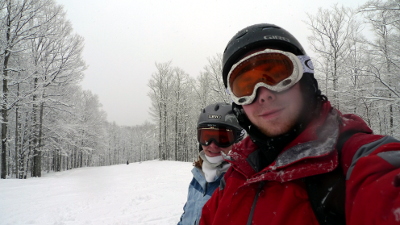
Another thing that frustrated me -- or that made my frustration worse -- was that I was really overheated. Partly this was because at first I was hardly moving, but it was also because I had 3 layers of clothes on: ski pants/shirt (basically thermal underwear), then sweatpants and long-sleeve shirt, and finally snow pants and jacket. I guess that’s because my first ski trip involved 10-degree temperatures, but this time it was right around 30 degrees, so the middle layer was definitely too much. Removing that helped a lot.
The mountain itself was pretty nice, comparable in size to Jay Peak, though of course nothing like Steamboat Springs. But to me (with relatively little experience) the trails seemed long and numerous enough, and there were no lift lines since we went during the week. There were quite a few trails and lifts closed though, so your options for runs were somewhat limited. But as with our Jay Peak trip, there were some runs where we had the whole trail to ourselves, and none that were crowded by any means.
To Ski or Not to Ski
Part of the reason our first day of skiing wasn’t longer was that I had to rent skis and boots and poles before we could get out there. Renting makes sense the first time you ski, and probably the second time, but by now, the time and hassle and expense of renting are starting to irritate me. It doesn’t help that all the guys in the rental shop are obviously way cooler than me, and I look like a total noob getting my little rentals. (As an aside, the stereo in the rental shop was blasting out music, and I noted several Tool tracks followed immediately by Billy Joel -- ??)
Another reason I rent, though, is that I haven’t yet decided whether to be a skier or a snowboarder. I haven’t yet tried snowboarding, having only been on 3 short ski trips in my life. So until I get a chance to snowboard and make up my mind, I’m going to be stuck with rentals.
But this trip, especially that first trail where I just kept falling, reminded me of what I hate about skiing: the boots and the leg pain. Ski boots are just so freakin’ heavy and uncomfortable. The leg pain is just because I’m not a super athlete like Kim (I mean, she really is), especially during the winter. I’m in pretty good shape, but skiing is just so hard on your legs; it takes tons of strength and control to be able to keep the skis together and to make the turns. You have to move your legs independently, and it’s become clear to me that one of my legs is much stronger (or at least easier to control on turns) than the other. We did get a sweet exercise bike a couple weeks ago, so in the future this will be less of an issue since I’ll be able to bike in the winter.
However I also realized that this is one huge advantage of snowboarding over skiing: since your feet are locked in place on a snowboard, you don’t have to be constantly fighting (and straining) your legs to keep them in position relative to each other. I’m sure that you still need some leg strength to be decent at snowboarding, but you’re doing different things with your legs than a skier does, and it seems to me that in this respect I’ll like snowboarding a lot better.
So whether I will actually end up liking snowboarding better, I don’t know yet, but I’ve decided that I’m snowboarding on our next winter trip.
North Creek Restaurants
There aren’t a ton of restaurant choices in and around North Creek, at least not during the week, because several of them are closed Monday through Wednesday, or Tuesday through Thursday, etc. But considering the size of the main street area of the town, the restaurant selection is not bad. And it’s nice that the handful of restaurants are all within short walking distance of the lodge.
On Wednesday morning we ate breakfast at Marsha’s Family Restaurant. At around 10 AM, we were one of only two groups there. This is a typical diner-type place, which we don’t really like, but it wasn’t bad.
For dinner we went to Trapper’s Tavern, which is inside the Copperfield Inn. It’s beautiful inside, with lots of exposed log architecture. And with 4 or 5 other groups there, it was the busiest place we saw. We weren’t blown away by our meals, but they were pretty good and we’d probably go back.
On Thursday morning we went to Common Roots for breakfast. It was again sort of typical diner fare. Suspiciously, the "home fries" were exactly the same as the ones from Marsha’s. As always, I requested them to be extra crispy at both places; both waitresses said OK; neither place actually did it.
Lorenzo’s in North Creek
Thursday night’s dinner was the food highlight of our trip. We ate at Lorenzo’s, which is the other restaurant inside the Copperfield Inn. We were the only people in the whole place, but we did get there at 5 PM right as they were opening. It looks extremely fancy, and you’d think there’d be a dress code, but there isn’t; their menu even has a statement to the effect of "we will strive to provide a high-class dining experience without any pretension."
The waiter perfectly embodied this philosophy: he was dressed in formal attire and was extremely professional, yet also very friendly and helpful. He seated us right in front of the brick oven, which is the centerpiece of the open kitchen area. We could also see the freshly-made pasta drying on racks by the oven. And when I placed my order, part of which was the Baked Roman Style Semolina Gnocchi, the waiter recommended the Gnocchi in Parmesan Fondue instead, because it’s apparently a customer favorite.
Everything on the menu sounded wonderful, and I decided to get three smaller dishes so I could try more things: the aforementioned Gnocchi in Parmesan Fondue, the Crispy Calamari with Smoked Tomato Vinaigrette, and the Roasted Radicchio di Treviso ("A hearty lettuce lightly marinated and roasted"). The gnocchi dish was one of the most creamy and delicious things I’ve ever eaten. The calamari were perfect: crispy, tender, and delicious. They’re served with the vinaigrette on the bottom, underneath the heaping pile of calamari, so as not to allow the strong sauce to overpower the flavor and crispiness of the calamari. And indeed, once I got down to the sauce, every bite was a difficult decision, because the crispy calamari alone were amazing, but they were also great dipped in the sauce.
The radicchio was the only thing I didn’t like; I think it just had a particular spice in it that I didn’t care for. Or maybe we just hate vegetables, because Kim got the Grilled Broccolini, and we were both lukewarm on that as well. But her main dish was one of their brick oven pizzas, and she absolutely loved it -- which is especially high praise because Kim, like me, is a picky pizza eater.
In addition to being extremely pleased with the food itself, Kim and I were both amazed at the speed with which the chef prepared all 5 dishes. The chef’s name was Denver, and since we were seated right next to the open kitchen, and we were the only guests there, we could see her preparing everything. Just like the waiter, Denver was very friendly, and we had a nice chat with her after our food was served.
The restaurant has a great atmosphere as well, partly because of the many huge windows which give a nice view of the snowy pine trees outside. We ate right around dusk, and there was lots of snow falling, which combined with the light and warmth of the brick oven to create a really cozy setting.
Our meal at Lorenzo’s was certainly among the best dining experiences we’ve ever had.

We drove home on Friday, and hit some snow on parts of this drive too. Driving through upstate New York, you pass through long stretches with nothing but trees surrounding the highway, and because of all the snow that had fallen, many of these huge trees were leaning way over, some actually onto the road. It was pretty crazy. And we tried to stop at a couple of restaurants, but they were stuck under a couple feet of snow and still being dug out around noon. Finally we found an Applebee’s that was open.
It was a pretty great trip overall. The North Creek area is really nice, and the brochures in the area advertised fun summery water activities too, since it’s right on the Hudson, so we might even go back for a hiking/rafting/kayaking trip during the summer months.
The Crusade Against Bottled Water
There was a segment on the Factor last week about a documentary called "Tapped," which is apparently one of these plastic-is-evil-and-so-is-bottled-water deals. They invariably show footage of some polluted stream or lake with a plastic water bottle floating on it. The implication is clear: if you drink bottled water, you’re an evil consumer who hates the earth.
Never mind that plastic water bottles are fully recyclable. No, the bottle-haters would have you believe that whenever someone finishes a bottle of water, they take the empty bottle to the nearest river, lake, or ocean and toss it right in.
Of course if you drink bottled water, you’re also an idiot, because half the kinds of bottled water sold are really just purified tap water! You big dummy! Never mind that a) such purified water actually says "purified water" right on the label, so anyone who specifically wants spring water instead (as I do) just buys spring water instead, and b) there’s not actually anything stupid about buying purified tap water because it’s cleaner than raw tap water.
But buying bottled water is just wasting money, because tap water is free! Well, no; in most places, tap water isn’t free. You either pay a monthly water bill, or you pay for the electricity and maintenance of a well and whatever equipment your system uses to clean and/or soften the well water. And the water isn’t exactly the same either; people who want good clean drinking water from their tap often install for example a Brita filter which is of course not free. Finally, the bottle-haters dishonestly use the $1+ per bottle, single-bottle price in their comparisons, not the 21-cents-per-bottle price that you pay when you buy it by the case.
And let’s not pretend that tap water is necessarily clean and pure; quite often it’s filthy and nasty. In our case, we used to have a well, which produced water that was decent sometimes, but anytime it rained, the tap water turned brown. So we switched to municipal water -- which was quite expensive, but not nearly as expensive as fixing or replacing the well would have been -- and now what comes out of the tap is basically pool water. I can barely stand to brush my teeth with it because of the chlorine taste. And whenever there’s a storm, they crank up the chlorine level even further -- since storms cause raw sewage to overflow into the rivers that supply our tap water -- to the point where I literally cannot stand to put the tap water into my mouth because of the chlorination.
Bottled water makes that a non-issue. And there are plenty of other benefits to bottled water, independent of any purity or cost issues. It is of course extremely convenient to be able to grab a bottle to take with you whenever you’re going out, or exercising, or taking a hike or a bike ride. And having a few cases of bottled water in your house is good disaster preparedness, whether it’s just a small electricity/water outage, or a more serious long-term situation like a blizzard, hurricane, earthquake, EMP, etc.
If you want to drink tap water, and advocate the drinking of tap water, go right ahead; but don’t be a fascist about it. There’s nothing stupid or evil about bottled water.
Sardines
I ate sardines for the first time today. They weren’t terrible, but weren’t exactly enjoyable either. They look and just seem pretty gross; in fact they taste a lot like what wet cat food seems like it would taste like: just really mushy and salty.
Come to think of it, they taste about how you’d expect a bunch of little fishs stuffed into a can to taste.
Oh well. At least now I know that, should I ever find myself in a situation where my very survival depends on eating sardines, it won’t be a problem.
Breakfast
Thanksgiving Breakfast
Kim makes a mean bacon, mushroom, tomato, and cheddar omelette. It’s getting to where there’s no point in ordering these at restaurants anymore because they’re so inferior.
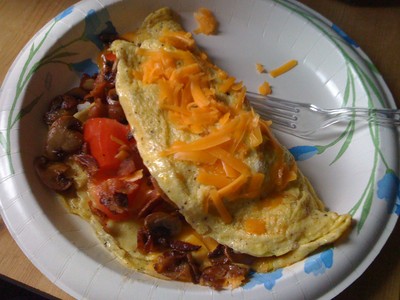
Chicken Madeira at The Cheesecake Factory
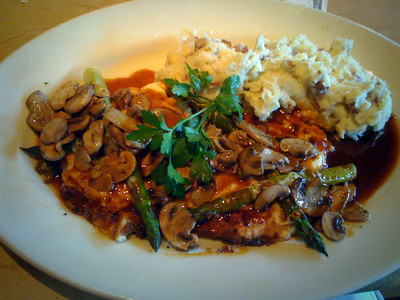
The Cheesecake Factory’s Chicken Madeira is probably my favorite meal. I’ve had it about 5 times, and I think it’s the only dish I’ve ever ordered at The Cheesecake Factory.
This isn’t the most visually-appealing rendition of the dish that I’ve had, but it was delicious as always. The chicken is absurdly tender, lightly coated in some kind of egg-based batter, fried so it’s a little crispy on the outside, then covered in mozzarella, mushrooms, and the amazing, slightly sweet Madeira wine sauce.
The couple of asparagus spears are a nice touch, and the mashed potatoes are really good too, but don’t kid yourself: you’re here for the chicken.
Chicken Wings for Lazy People
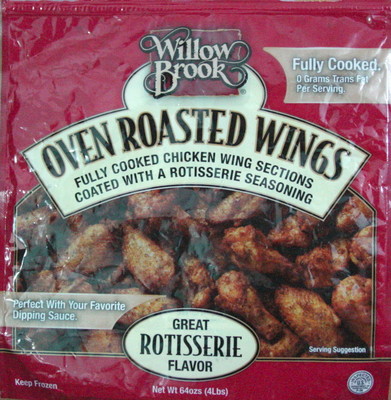
These chicken wings are delicious, and they’re super easy: just put them on a baking tray at 385F for 35 minutes, and they come out juicy and a little crispy and just perfect. The package says "Perfect With Your Favorite Dipping Sauce" but the truth is they’re perfect as is: they come with a dry-rub kind of seasoning which is just a little spicy and really good.
Also, there’s this:
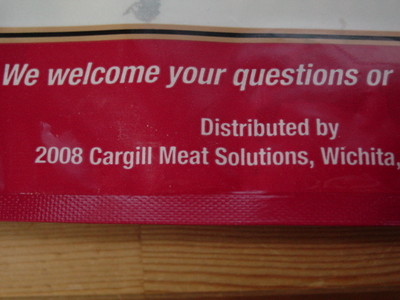
"Meat Solutions" is made of win if anything ever was.
The only downside to these wings is they’re apparently only available through Sam’s Club.
100 Things Restaurant Staffers Should Never Do
Interesting list in the "You’re the Boss Blog" on the New York Times. It’s clearly meant for a more fancy restaurant than the kinds we usually visit, but I can’t help wishing all restaurants took these kinds of things seriously. In fact many of the items are just obvious, common-sense, good-manners issues, so it’s sad how many restaurants and servers are deficient in these areas.
Quoting Bruce Buschel:
12. Do not touch the rim of a water glass. Or any other glass.
13. Handle wine glasses by their stems and silverware by the handles.
25. Make sure the glasses are clean. Inspect them before placing them on the table.
33. Do not bang into chairs or tables when passing by.
34. Do not have a personal conversation with another server within earshot of customers.
35. Do not eat or drink in plain view of guests.
36. Never reek from perfume or cigarettes. People want to smell the food and beverage.
45. Do not curse, no matter how young or hip the guests.
47. Do not gossip about co-workers or guests within earshot of guests.
56. Do not ignore a table because it is not your table. Stop, look, listen, lend a hand. (Whether tips are pooled or not.)
62(a). Do not let a glass sit empty for too long.
66. Do not return to the guest anything that falls on the floor -- be it napkin, spoon, menu or soy sauce.
68. Do not reach across one guest to serve another.
71. Do not race around the dining room as if there is a fire in the kitchen or a medical emergency. (Unless there is a fire in the kitchen or a medical emergency.)
77. Do not disappear.
78. Do not ask, "Are you still working on that?" Dining is not work -- until questions like this are asked.
I also loved this one:
11. Do not hustle the lobsters. That is, do not say, "We only have two lobsters left." Even if there are only two lobsters left.
Kettle Corn
Today Kim came home with two big bags of Hall of Fame Kettle Corn popcorn from Dale and Thomas. It’s really good: a little sweet and a little salty. The sweetener they use in it is sugar -- crazy, right?
A few years ago I discovered this kind of sweet and salty "kettle corn" popcorn at the grocery store. It was made by Pop Secret and I loved it. But one day I happened to notice the ingredients and saw that it was sweetened not with sugar, but with sucralose (Splenda). Of course I’m not going to intentionally eat that crap, so I had to give up the kettle corn, as every brand I found in the grocery store was sweetened with sucralose instead of sugar.
I can understand why some companies would choose an artificial sweetener over sugar: it’s likely cheaper than the real thing, and many consumers are obsessed with the idea of a magical substance that will allow them to lose weight while eating too much, which is how these substances are marketed. But I couldn’t believe there wasn’t a single popcorn maker who used natural sweeteners in their popcorn.
Well, Dale and Thomas does, so kettle corn is back.
Vitamin D, Or: You're Not Getting Enough Sun
Over the past few months I’ve been hearing more and more about vitamin D deficiency. Then a few weeks ago Steve Gibson, the guy who does the Security Now podcast, took a rare diversion from security to talk about vitamin D (podcast here). He created a page about vitamin D explaining everything and citing all the research he’s read, and that page also links to some good videos on the topic: a 90-second video focused on cancer; another 90-second video on cancer and sun exposure; a 6-minute video on vitamin D’s effect on general health (money quote: people who take sufficient vitamin D supplements just don’t get sick anymore); and finally a 1-hour video full of tons of vitamin D science.
Certainly watch the 2-3 shorter videos, and watch the longer one if you have time. But the bottom line is this: many and probably most people are vitamin D deficient, especially in the winter months; and vitamin D deficiency is linked to not only many forms of cancer but also autism, bone diseases, tuberculosis, psoriasis, and many other diseases. And in particular, vitamin D deficiency during pregnancy and after birth can cause lots of problems for babies, most famously the disease rickets.
Crucially, vitamin D is not actually a vitamin at all; it’s a hormone. So it’s impossible to get a sufficient amount of vitamin D from your diet, unlike most real vitamins. The only way to get sufficient vitamin D is from the sun, or via supplement -- but a multivitamin will not give you nearly enough. For example, in milk that’s fortified with vitamin D, and in most multivitamins, there’s only a few hundred IU of vitamin D, whereas 10-20 minutes of noontime sun exposure will cause your body to create around 10,000 IU of vitamin D.
The problem is that in recent decades, due to the problem of skin cancer caused by overexposure to the sun, we have massively overcorrected, with the scientific, medical, and governmental guidelines generally recommending that we avoid the sun entirely, never being exposed to it without sunblock. But since sunblock blocks virtually all UVB, your body doesn’t make any vitamin D when you’re covered in sunblock.
The solution is to get a moderate amount of noontime sunlight on a daily basis. As mentioned above, just 10-20 minutes will boost vitamin D levels into the healthy range, and will not give you a sunburn. It must be within about 2 hours of solar noon though -- which is 1 PM in the northern hemisphere -- because outside that range, the sun’s angle in the sky forces it to travel through much more atmosphere, which totally blocks UVB outside of about 10AM-4PM. That’s also the reason it’s much harder to get a sunburn except within a couple hours of solar noon.
But during the winter, unless you live very close to the equator, the sun’s angle again prevents it from delivering enough UVB to generate healthy amounts of vitamin D in your skin. Because of this, and because you can’t get sufficient vitamin D via diet, I plan to start taking a vitamin D supplement soon; Steve Gibson’s vitamin D page has his recommendations about halfway down the page, and in terms of dosage it appears that 2000 IU/day is a good amount. And that’s about an order of magnitude below the level at which toxicity begins to become an issue.
This topic fascinates me partly because of its obviousness: for all of human history we’ve been exposed to at least some sun nearly every day, so the idea that we should now suddenly start avoiding it altogether is just insane. It appears that we’re now suffering many unintended consequences of that advice. There are lots of interesting statistics in the videos above, but one that sticks out to me is that, for some forms of cancer, vitamin D deficiency causes a doubled risk of metastases and a 75% increased risk of mortality.
Cape Cod: Great Beaches, Bad Restaurants
Last week, we took a fun little vacation to Cape Cod. We left Sunday and returned Thursday, but because the drive takes a whole day -- it’s nominally ~7 hours, but longer if you include a few bathroom breaks and a meal stop -- we really only spent 3 days there.
Our plan was to camp, because we like that and we’re used to camping at the Jersey shore. But the campground doesn’t let you check in after 9 PM, so we had to stay in a hotel the first night. The brand-name hotels were all around $200 per night, so I tried to find something cheaper, and found Cape Point Hotel for $135. It turned out to be pretty terrible: the hallway to our room and our room itself had a strange gross smell; the air conditioner continually turned itself off and on despite being set to stay on; the handle on the toilet fell off when you touched it; and, as we checked out, the woman at the desk didn’t even ask how our stay was. I assume she already knew.
On Cape Cod you have the bay on the north shore, the sound on the south shore, the ocean on the east shore, and then you have lots of huge inland ponds. On the first day we checked into the campground around 1 PM, set up camp, and then walked the ~1 mile to the bay. But it was low tide when we arrived there at around 3 PM, and low tide on Cape Cod Bay means you need to walk about three-quarters of a mile to get to water that’s more than ankle-deep. It was neat to see, especially the dozen or so boats that were anchored and sitting on dry land due to the low tide, and the water was quite warm, probably 75F or slightly warmer. And it was nice and uncrowded, with perhaps 100 people spread across the one square mile or so of beach and bay.
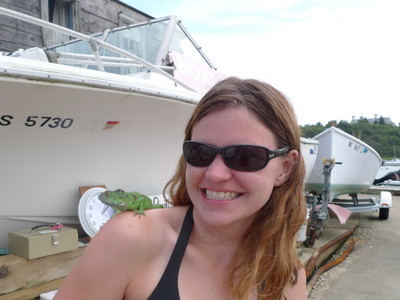
But I really wanted to get into some real ocean water that was cool and deep enough to swim in. On the second day, we mapped a bike ride across the peninsula to Nantucket Sound. Starting at our campground in Brewster, it was a short 1.5 mile ride on route 137 to Underpass Road, where we picked up a bike path that goes almost right across most of the peninsula. We got off the path at Lothrop Ave and took that to Earle Road, which led us right to Earle Road Beach. It’s a small beach, probably not even a football field long, but we arrived around 10 AM and there were only 3 or 4 other groups there. It had decent waves despite technically being the sound and not the ocean, and the water temperature was perfect, probably about 73-75F. As a longtime Jersey shore beachgoer, I loved how soft and shell-free the sand was, and how clean the water was. After an hour or so, we biked back across the cape to our campsite. The ride was 8.5 miles each way, which took us about 50 minutes, so it was a good ride -- and it was neat to pass several of the huge ponds along the way. We’ll definitely have to swim in some of those next time.
Later in the day we drove up the cape, in search of sand dunes and a nice ocean-side beach, which we eventually found (thanks to Brian’s navigational help) in Wellfleet. At this particular beach the parking area is about 75 feet above sea level, so you have to take one of two steep diagonal trails down the face of the sand dune to get to the beach. It was late in the day when we arrived, so we didn’t swim, but I did walk into the water up to my shins, and it was cold. The water was nice and turquois, though, as you can see in the satellite view, so I think we’ll probably make a point to swim here on our next trip.
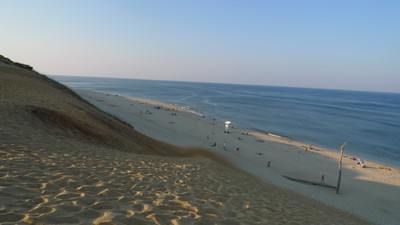
On our third and final day, we rented kayaks from The Chatham Kayak Company. The fancy name contrasts with the extremely informal (in a good way) nature of the operation: you drive to the end of Barn Hill Road, make a hard left just before the parking lot, and Anne or John emerges from a shack to take your information and put you into a kayak. They’re right on the water of Oyster Pond River, so you’re into the water and ready to go pretty quickly. We headed towards Stage Harbor, then went out the small channel into the sound (or technically, I guess it’s Sequetucket Harbor at that location). We went about 2 miles, not quite making it to the ocean, but we did get into some waves, and in fact I capsized my kayak on one of them. This turned out to be a good thing, because I lost our only water bottle when I flipped, which meant that we had to head back; and we ended up with pretty decent sunburn after the ~2.5 hour trip as it was, so we’d’ve been in bad shape if we stayed out much longer. Here’s the route we took:
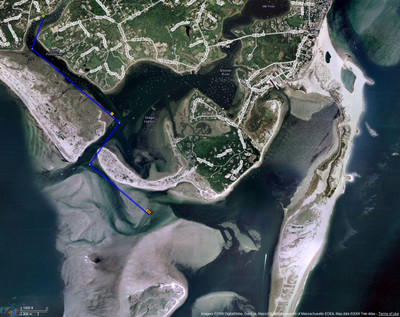
The kayak trip was the highlight of the vacation, though. We’ve kayaked a few times before, but never on open water like that. It was really neat to be able to just go wherever you wanted, and to stop at beaches which were inaccessible except by boat and therefore totally devoid of people. Not having kayaked much before, I forgot that there’s actually a lot of room in the boat for stuff like water bottles, extra sunblock, etc; had I realized that, I would have brought a backpack with enough supplies to turn it into a half day’s adventure.
The Restaurants
The nice water, beaches, and bike trails on Cape Cod are unfortunately beset by countless restaurants -- bad restaurants -- which were the downside of an otherwise awesome trip.
On the first morning, we ate breakfast at Hearth ’n Kettle. This place looks promising: nice on the outside and country-style on the inside, like a less fake version of Cracker Barrel or Bob Evans. But once seated, we had a longish wait before our waitress noticed us and took our orders. My omelette was made of something other than natural eggs; I’ve never knowingly eaten "egg beaters" or anything like that, but that’s what I thought of -- it was slightly rubbery, perfectly smooth on top, and just unnatural. The "home fries" were new potatoes that were just halved and deep fried, rather than cut up and pan-fried. But that stuff is minor compared to what happened when the waitress brought out the tray of food for the table across from us. She accidentally knocked a piece of toast off a plate and onto the surface of the tray, then grabbed it with her bare hand, fumbled it a few times and generally just smooshed it around on the dirty tray surface, and then placed it back onto the plate. This happened right next to us and away from the table where the food was going, so they probably didn’t see it; Kim and I just watched in horror.
Before the trip, I spent a fair bit of time researching restaurants on Fodor’s and TripAdvisor. The #1 Cape Cod restaurant on TripAdvisor is Moby Dick’s, and after reading the reviews, it seemed like a safe bet. When we arrived there was a long line with an hour-long wait, but it ended up being only a half an hour due to some people bailing out early. We were seated in what appears to be the only section in the whole place, which is basically a screened-in deck with powerful overhead fans blowing right on you and your food. (I do recall being asked whether we wanted to choose where we sit, or take the first available table; this was after our long wait to get in, so we opted for first available, but I assume that perhaps this means there actually is another section, which is hopefully more indoors and nicer.) I had never had a lobster roll before, and since they’re all the hype on Cape Cod, and since I love lobster, I decided to try one. It wasn’t bad, but was certainly nothing special; and I gather that they’re supposed to be cold, but I guess I just don’t care for cold lobster. The bread/roll was just barely toasted, and it was overall pretty small, I’d guess 8-10 ounces. The presentation certainly left something to be desired (see photo below). So on the whole, Moby Dick’s wasn’t terrible, but was not especially good either. I doubt we’ll go back.
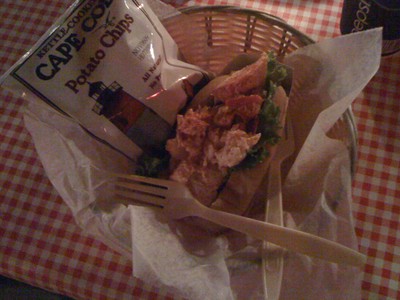
In the mornings, I made a campfire and roasted up some bratwurst and sausage; these were by far the best meals I had on Cape Cod:
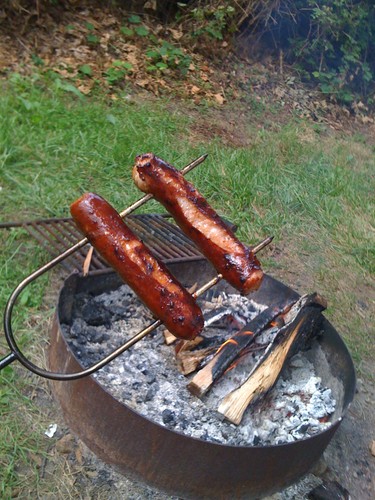
Our next meal out was at Carmine’s in Chatham. This is a pizza shop, and I thought the pizza was decent, though nowhere near as good as Mack and Manco or Grotto. Kim wasn’t crazy about it. However, considering that I am apparently a pizza snob, the fact that I think Carmine’s is OK might actually be a decent compliment for them. I wouldn’t mind getting pizza here again. The one downside was that there’s no bathroom, which means nowhere to wash your hands; you have to walk out the back of the building, around a corner past another building, and across a parking lot to get to public restrooms (they were nice restrooms though).
Another restaurant that had good reviews was The Paddock, so we went there on our second night. This place looks nice and fancy; it doesn’t have a dress code, but they do the full table sets with proper silverware and plate layouts, wine glasses, etc. They served pre-meal bread with dipping oil, which I love, and this particular oil also had some kind of tomato-based herb mixture under it, and it was amazing. My salad was also quite good, and my meal -- peppercorn-encrusted swordfish -- was really good too. However, it was more like peppercorn-conquered swordfish -- not a bad thing in my book -- which made it really spicy, and I finished my tiny-wine-glass portion of Coke in no time. I couldn’t continue to eat it without more beverage; and Kim was also at an impasse with her meal at this point. But after delivering our meals, our waitress abandoned us for at least 15 minutes (Kim thinks it was even longer), during which time we watched her yakking it up with various other patrons across the room. When she finally returned, and found us sitting there staring at our plates, she asked something like, "Oh, are you not enjoying your meals?" I said no, we’re waiting for refills on our drinks, to which she replied "Oh, we don’t do refills here; but maybe I could bring you new ones?" So she chose to interpret my request as a wish to have those specific glasses refilled, rather than the obvious interpretation which is we need more to drink. She made it seem like there was something wrong with me, as if additional drink is an unusual request, and she never apologized for disappearing for most of our meal. To top it all off, she charged us for the extra drinks, at $4.50 each -- for soda!
Our final Cape Cod restaurant stop was at JT’s Seafood Restaurant. The sign by the road for this place is fancy, making it seem like this will be an at least somewhat fancy restaurant. But when you get inside, it’s set up like a cafeteria. There’s a big board on the wall with those slidey plastic letters; this is the menu. You order and pay for your food, then go sit down and wait for them to bring it to you. The place seemed decently clean, but the decor was just... ridiculous. The dining room is half tables, half booths, with the booths on a raised level; the walls were white and mostly bare; the music was... I don’t remember except that it was bad. I can’t quite put my finger on what was wrong with the layout and decor, but it just didn’t make sense; things didn’t go together, and it kind of seems like it was someone’s house that they just put some booths and tables into. All of that is subjective so maybe it’s not entirely fair, but Kim and I both just got a weird vibe from the setup. The real problem, though, was that the lobster I ordered came on a paper plate. With a piece of corn-on-the-cob and a biscuit on top of the lobster. And plastic silverware. You have to take everything except the lobster off the plate to start working on the lobster, and of course lobster is a big mess with tons of water coming out of it, which quickly turned the paper plate into a disaster. And the lobster was $20, which isn’t hugely expensive, but I had thought that lobster was supposed to be so cheap in New England.
IHOP, Save Us!
Fortunately, Cape Cod does have a bunch of good chain restaurants. On our way out of town on Thursday morning, we got breakfast at IHOP, and it was wonderful. And we had previously gotten dinner at Outback Steakhouse on the way to Cape Cod, about halfway into the trip; I got tilapia covered in mushrooms and crab meat, which was wonderful, and Kim got ribs -- Outback was great, as it consistently is. And on the cape we did see an Olive Garden, a Pizzeria Uno, and a Friday’s, all of which we like and are usually very good. We should have cut our losses after the first or second disappointing local restaurant, but I wanted to believe we could find something good. But at least we know for next time: pack more campfire food, and eat out at the known-good restaurants.
While researching restaurants before the trip, I did come across an article titled "On Cape Cod, Desperately Seeking Seafood" in the Washington Post; I guess I just didn’t want to believe it:
Quoting The Washington Post:
I presumed the crowds happily standing in line to order were there for the food.
I presumed wrong. The fried clams were indistinguishable from the onion rings, which tasted remarkably like the fried shrimp. After a few bites I felt as if I had rubbed a bowl of grease onto my face.
"You don’t come to the Cape to eat," my husband explained, polishing off his french fries, or were they clam strips? [...]
You have to seek [good food] out, to distinguish by trial and error the few spots that are good from the many that are adequate or worse.
And that’s the problem: Cape Cod is basically wall-to-wall restaurants, and -- in that author’s experience, and ours -- few of those restaurants are good.
Exercise Makes You Fat
OK, so maybe that’s not exactly what this Time Magazine article says:
[T]he peer-reviewed journal PLoS ONE ... published a remarkable study ... The findings were surprising. On average, the women in all the groups, even the control group, lost weight, but the women who exercised - sweating it out with a trainer several days a week for six months - did not lose significantly more weight than the control subjects did. ... Some of the women in each of the four groups actually gained weight, some more than 10 lb. each. [...]
Whether because exercise made them hungry or because they wanted to reward themselves (or both), most of the women who exercised ate more than they did before they started the experiment. Or they compensated in another way, by moving around a lot less than usual after they got home. [...]
"I see this anecdotally amongst, like, my wife’s friends," [Dr. Church] says. "They’re like, ’Ah, I’m running an hour a day, and I’m not losing any weight.’" He asks them, "What are you doing after you run?" It turns out one group of friends was stopping at Starbucks for muffins afterward. Says Church: "I don’t think most people would appreciate that, wow, you only burned 200 or 300 calories, which you’re going to neutralize with just half that muffin."
I recently discovered that my eating habits were affecting my weight far more than my level of exercise.
Sometime about 6-8 years ago, while I was in college, I noticed that I ate about every 4 hours. At that point, I guess I subconsciously decided that that was when I was supposed to eat, because ever since then, that’s been the main determinant in deciding when I should eat.
A few months ago, I noticed that my stomach fat was getting a little out of hand, and for some reason it occurred to me that the whole every-4-hours thing was totally arbitrary. I mean, sure I was hungry at ~4 hours, but what if I stretched it to 6 hours instead? Over the course of a day that’d cut out an entire meal.
So I started doing that, and sure enough, in 2-3 months, I’ve lost 15 pounds. I was previously right in the middle of the "overweight" range on the BMI scale -- and no the BMI theory is not perfect, but it’s a useful metric -- whereas now I’m just barely inside the "normal" range.
I’ve also started paying attention to the quantities of food that I eat. For example, going out to a restaurant and eating the bread, the salad, the appetizer, and the whole entree -- which I used to do, even though I was stuffed afterwards -- is just ridiculous. And for most of my life I’ve been able to eat huge amounts of everything and not gain weight; that of course changed in my mid-20s and it’s taken some conscious effort to stop eating that way.
But my point is that I achieved this not-insignificant change in my weight purely by adjusting my eating habits -- and only the timing and quantity, not what I eat. I go for a 2-mile walk a couple times per week, and a ~10-mile bike ride maybe once or twice a week, which is the about same level of exercise I’ve done for the past few years.
Healthy Food For Lazy People
There’s a stereotype that geeks eat a lot of junk food. But other than Utz Party Mix and a particular kind of potato chip, I’d say what I tend to eat is more "snack food" than "junk food". I eat a lot of mixed nuts, almonds, and sunflower seeds, as well as popcorn and granola bars.
I’ve come to realize that laziness is the primary factor in determining what I eat. I will almost always choose, say, a can of mixed nuts that I can just crack open and eat over something that I need to prepare.
In light of this, I’m trying to come up with & keep on hand foods that are more healthy but still require little or no preparation. Here are some of my staples:
bananas
orange juice with "lots of pulp"
pickles
salsa & tortilla chips (OK, and cheese)
apple sauce (in individual 4-oz containers)
berry apple sauce
granola bars and nuts, as mentioned
What else should be on my list?
Home – Create Post – Archives – Login – CMS by Encodable
